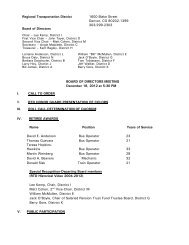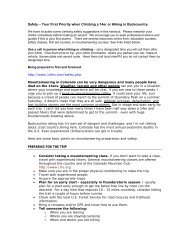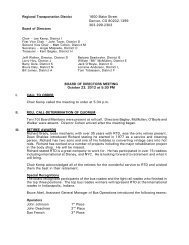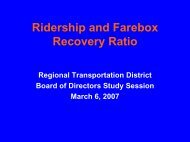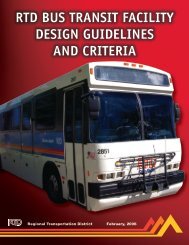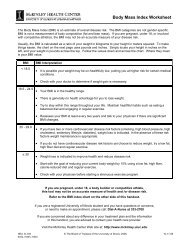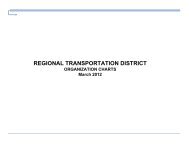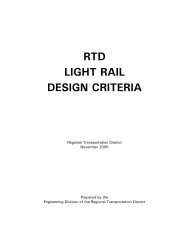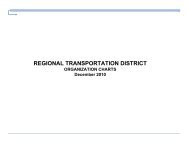Commuter Rail AC Electrification Load-Flow Simulation Report - RTD
Commuter Rail AC Electrification Load-Flow Simulation Report - RTD
Commuter Rail AC Electrification Load-Flow Simulation Report - RTD
You also want an ePaper? Increase the reach of your titles
YUMPU automatically turns print PDFs into web optimized ePapers that Google loves.
<strong>Commuter</strong> <strong>Rail</strong> <strong>AC</strong> <strong>Electrification</strong> <strong>Load</strong>-<strong>Flow</strong> <strong>Simulation</strong> <strong>Report</strong> Revision 1<br />
• Two paralleling stations were located along the East Corridor,<br />
• One paralleling station was located along the Gold Line, and<br />
• Three paralleling stations were located along the North Metro Corridor<br />
The purpose of the paralleling stations is to parallel the catenary and feeder systems, provide<br />
feeder and catenary sectioning, and to supply power from the feeder/catenary system to the catenary/rail<br />
system.<br />
Two sets of traction power supply system studies were performed, with substations connected<br />
to Xcel Energy’s 115 kV transmission network and configured as follows:<br />
• In the first study set, both substations, Sandown and Argo, were equipped with two<br />
traction power transformers.<br />
• In the second study set, the Sandown substation was equipped with two traction power<br />
transformers and the Argo substation was equipped with only one traction power<br />
transformer.<br />
The modeled autotransformer system provided a significant operating margin for the electrical<br />
traction power system. Minimum voltages along the three corridors were well above industry<br />
standards ensuring satisfactory operation under normal operating conditions, with all systems in<br />
service, and under particularly severe contingency operation with one substation (both<br />
transformers) out-of-service. The total system power demand averaged over 2 hours is<br />
approximately 15 MVA. Taking into consideration the fluctuating power demand of the traction<br />
power loads, short-term overloads and the requirement for transformer and substation<br />
contingency operation, a preliminary continuous rating of 12.5 MVA should be considered for<br />
each substation transformer when two transformers per substation can be installed. In the<br />
event that only one transformer can be installed in Argo substation, it is recommended that 15<br />
MVA rating for each transformer be considered. Further, it is recommended that a standard<br />
continuous rating for each autotransformer be 2.5 MVA. These ratings would allow operation of<br />
EMUs on the East Corridor, Gold Line, and the North Metro Corridor.<br />
Since the autotransformer-fed system performed with a significant operational margin,<br />
consideration should be given to the utilization of 1x25 kV direct-fed system. Preliminary results<br />
indicate that the 1x25 kV system might be effective but more comprehensive simulations would<br />
be required to ensure its viability. It is believed that this alternative system would be much<br />
simpler, substantially less expensive to build and maintain, and provide more efficient utilization<br />
of equipment.<br />
Regardless of whether an autotransformer-fed system or direct-fed system is selected for<br />
implementation, it is recommended that a utility impact study be performed. A key element of<br />
the study should be investigation into the effects of the fluctuating traction power load on the<br />
transmission system including a voltage flicker study. The unbalanced nature of the load due to<br />
phase-to-phase substation transformer connections should be evaluated and the levels of<br />
negative sequence currents in nearby generators determined. Further, the study should<br />
evaluate the effects of harmonics generated by the rolling stock on total and individual harmonic<br />
distortion of voltages and currents at the point of common coupling and assess the likelihood of<br />
utility system resonance.<br />
02/27/2009 FRSC Page 2 of 250




